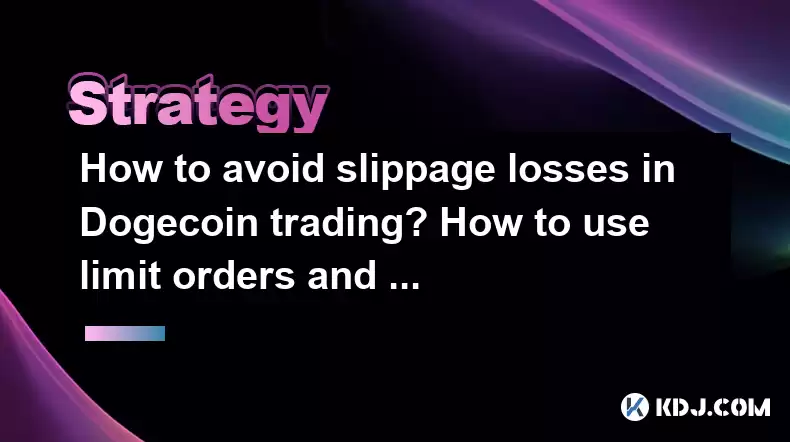-
 bitcoin
bitcoin $107208.295278 USD
-1.54% -
 ethereum
ethereum $3874.629914 USD
-1.38% -
 tether
tether $1.000440 USD
0.03% -
 bnb
bnb $1089.465513 USD
-5.53% -
 xrp
xrp $2.327672 USD
-1.65% -
 solana
solana $184.766505 USD
-0.73% -
 usd-coin
usd-coin $1.000076 USD
0.02% -
 tron
tron $0.310632 USD
-1.99% -
 dogecoin
dogecoin $0.187615 USD
-1.60% -
 cardano
cardano $0.633389 USD
-2.75% -
 ethena-usde
ethena-usde $0.999553 USD
0.03% -
 hyperliquid
hyperliquid $35.608231 USD
-4.13% -
 chainlink
chainlink $16.876114 USD
-3.98% -
 stellar
stellar $0.312239 USD
-0.91% -
 bitcoin-cash
bitcoin-cash $473.262969 USD
-7.09%
How to avoid slippage losses in Dogecoin trading? How to use limit orders and market orders?
To minimize slippage in Dogecoin trading, use limit orders to set specific prices and trade during high liquidity periods; avoid large orders and volatile times.
May 04, 2025 at 09:35 pm

Trading in the cryptocurrency market, particularly with volatile assets like Dogecoin, can be both exciting and risky. One of the key challenges traders face is dealing with slippage losses. Slippage occurs when there is a difference between the expected price of a trade and the price at which the trade is actually executed. This article will explore strategies to avoid slippage losses in Dogecoin trading and provide a detailed guide on using limit orders and market orders effectively.
Understanding Slippage in Dogecoin Trading
Slippage is a common phenomenon in trading, especially in highly volatile markets like cryptocurrencies. In Dogecoin trading, slippage can occur due to sudden price movements or low liquidity. When you place a market order, you might expect to buy or sell at the current market price, but if the market moves quickly, you could end up trading at a less favorable price. Understanding the factors that contribute to slippage is crucial for minimizing its impact on your trading strategy.
Strategies to Avoid Slippage Losses
To minimize slippage losses in Dogecoin trading, you can employ several strategies. One effective method is to use limit orders instead of market orders. Limit orders allow you to set a specific price at which you want to buy or sell Dogecoin, ensuring that your trade is only executed at your desired price or better. Another strategy is to trade during periods of high liquidity, typically when trading volumes are higher, as this reduces the likelihood of significant price gaps between orders.
Using Limit Orders in Dogecoin Trading
Limit orders are an essential tool for traders looking to avoid slippage. To use a limit order for Dogecoin trading, follow these steps:
- Open your trading platform: Log into your preferred cryptocurrency exchange or trading platform.
- Navigate to the Dogecoin trading pair: Find the DOGE trading pair against the currency you wish to trade with (e.g., DOGE/USD or DOGE/BTC).
- Select the order type: Choose 'Limit Order' from the order type options.
- Set your price: Enter the price at which you want to buy or sell Dogecoin. For example, if you want to buy Dogecoin at $0.30, set your limit order price to $0.30.
- Set the quantity: Specify the amount of Dogecoin you want to trade.
- Review and submit the order: Double-check all the details, then submit your limit order. Your order will be added to the order book and will be executed when the market price reaches your specified price.
Limit orders help you control the price at which you trade, reducing the risk of slippage. However, keep in mind that there is a possibility that your order may not be filled if the market price does not reach your specified price.
Using Market Orders in Dogecoin Trading
Market orders are another type of order commonly used in trading. To use a market order for Dogecoin trading, follow these steps:
- Open your trading platform: Log into your preferred cryptocurrency exchange or trading platform.
- Navigate to the Dogecoin trading pair: Find the DOGE trading pair against the currency you wish to trade with.
- Select the order type: Choose 'Market Order' from the order type options.
- Set the quantity: Specify the amount of Dogecoin you want to trade.
- Review and submit the order: Double-check the quantity, then submit your market order. Your order will be executed immediately at the best available price in the market.
Market orders are useful when you want to enter or exit a trade quickly, but they can be more susceptible to slippage, especially in volatile markets. If the market is moving rapidly, the price at which your order is filled may differ from the price you see when you submit the order.
Combining Limit and Market Orders for Optimal Trading
To maximize your trading efficiency and minimize slippage, consider combining limit and market orders based on your trading goals and market conditions. For instance, you might use a limit order to enter a position at a specific price and a market order to exit the position quickly if the market moves in your favor. This strategy allows you to control your entry price while still being able to react swiftly to market changes.
When using both types of orders, it's important to monitor the market closely and adjust your strategy as needed. Keep an eye on liquidity levels and market volatility to make informed decisions about when to use limit orders versus market orders.
Practical Tips for Minimizing Slippage in Dogecoin Trading
In addition to using limit and market orders effectively, there are several practical tips you can follow to minimize slippage in Dogecoin trading. One tip is to avoid trading during times of high volatility, such as immediately after major news announcements or during periods of market uncertainty. Another tip is to use smaller order sizes, as large orders can have a greater impact on the market and increase the likelihood of slippage.
It's also beneficial to use trading platforms with robust order books and high liquidity, as these can help ensure that your orders are filled more accurately. Lastly, consider using stop-loss orders to limit potential losses if the market moves against your position, although be aware that stop-loss orders can also be subject to slippage.
Frequently Asked Questions
Q: Can slippage be completely avoided in Dogecoin trading?A: While it's not possible to completely avoid slippage in Dogecoin trading, you can significantly reduce its impact by using limit orders, trading during high liquidity periods, and employing other strategies mentioned in this article.
Q: How does the size of my order affect slippage?A: The size of your order can impact slippage. Larger orders can move the market price, increasing the likelihood of slippage. To minimize this, consider breaking up large orders into smaller ones and executing them over time.
Q: What are the risks of using market orders in volatile markets?A: In volatile markets, market orders can be risky because they are executed at the best available price at the time of submission, which may differ significantly from the price you see when you place the order. This can lead to higher slippage and potential losses.
Q: Are there any tools or indicators that can help predict slippage?A: While there are no specific tools or indicators designed solely to predict slippage, traders often use volume indicators, order book analysis, and volatility indicators to gauge market conditions and make informed decisions about when to place orders.
Disclaimer:info@kdj.com
The information provided is not trading advice. kdj.com does not assume any responsibility for any investments made based on the information provided in this article. Cryptocurrencies are highly volatile and it is highly recommended that you invest with caution after thorough research!
If you believe that the content used on this website infringes your copyright, please contact us immediately (info@kdj.com) and we will delete it promptly.
- Crypto News, October 2025: Missed Stories You Need to Know
- 2025-10-18 08:45:14
- PAX Gold (PAXG): Riding the Crypto Gold Rush in the Digital Age
- 2025-10-18 08:25:14
- Dogecoin, PEPE, and Remittix: Navigating the Crypto Landscape in Late 2025
- 2025-10-18 09:10:15
- Quant Eyes Rebound: Can $75 Support Level Hold?
- 2025-10-18 08:45:14
- Bitcoin's Wild Ride: Crypto Crash Wipes Out $600 Billion!
- 2025-10-18 08:25:14
- Crypto Market Check: Renewed Buying for ETH, ADA, SUI Amidst Market Jitters
- 2025-10-18 08:50:12
Related knowledge

Practical parameter settings for a Bitcoin multi-timeframe moving average system
Sep 18,2025 at 10:54pm
Optimizing Timeframe Combinations for Bitcoin Trading1. Selecting appropriate timeframes is crucial when building a multi-timeframe moving average sys...

How can I filter out false breakouts in Dogecoin high-frequency trading?
Sep 22,2025 at 01:00am
Understanding False Breakouts in Dogecoin Trading1. A false breakout occurs when Dogecoin's price appears to move beyond a defined support or resistan...

Techniques for identifying tops and bottoms in the Bitcoin on-chain NVT model
Sep 20,2025 at 07:54pm
Understanding the NVT Model in Bitcoin Analysis1. The Network Value to Transactions (NVT) ratio is often described as the 'P/E ratio' of the cryptocur...

What does the surge in open interest in Bitcoincoin futures mean?
Sep 20,2025 at 11:18pm
Understanding the Surge in Dogecoin Futures Open Interest1. A surge in open interest within Dogecoin futures indicates a growing number of active cont...

How can I use the Ethereum USDT premium to gauge market sentiment?
Sep 18,2025 at 11:55pm
Understanding the Ethereum USDT Premium1. The Ethereum USDT premium refers to the price difference between USDT (Tether) traded on Ethereum-based plat...

What should I do if Ethereum staking yields decline?
Sep 20,2025 at 06:18am
Understanding the Causes Behind Declining Ethereum Staking Yields1. The Ethereum network transitioned to a proof-of-stake consensus mechanism with the...

Practical parameter settings for a Bitcoin multi-timeframe moving average system
Sep 18,2025 at 10:54pm
Optimizing Timeframe Combinations for Bitcoin Trading1. Selecting appropriate timeframes is crucial when building a multi-timeframe moving average sys...

How can I filter out false breakouts in Dogecoin high-frequency trading?
Sep 22,2025 at 01:00am
Understanding False Breakouts in Dogecoin Trading1. A false breakout occurs when Dogecoin's price appears to move beyond a defined support or resistan...

Techniques for identifying tops and bottoms in the Bitcoin on-chain NVT model
Sep 20,2025 at 07:54pm
Understanding the NVT Model in Bitcoin Analysis1. The Network Value to Transactions (NVT) ratio is often described as the 'P/E ratio' of the cryptocur...

What does the surge in open interest in Bitcoincoin futures mean?
Sep 20,2025 at 11:18pm
Understanding the Surge in Dogecoin Futures Open Interest1. A surge in open interest within Dogecoin futures indicates a growing number of active cont...

How can I use the Ethereum USDT premium to gauge market sentiment?
Sep 18,2025 at 11:55pm
Understanding the Ethereum USDT Premium1. The Ethereum USDT premium refers to the price difference between USDT (Tether) traded on Ethereum-based plat...

What should I do if Ethereum staking yields decline?
Sep 20,2025 at 06:18am
Understanding the Causes Behind Declining Ethereum Staking Yields1. The Ethereum network transitioned to a proof-of-stake consensus mechanism with the...
See all articles























![[4K 60fps] 5upreme by RoyalP (1 coin) [4K 60fps] 5upreme by RoyalP (1 coin)](/uploads/2025/10/18/cryptocurrencies-news/videos/k-fps-upreme-royalp-coin/68f2e6c9ef491_image_500_375.webp)


















































